Analyzing Gender Roles and Stereotypes in Advertising and Media
VerifiedAdded on 2023/06/03
|8
|2216
|364
Essay
AI Summary
This essay delves into the portrayal of gender roles in advertising and media, examining how these representations shape societal perceptions and reinforce stereotypes. The introduction highlights the impact of gender bias and sex roles on the assignment of duties and the influence of media in perpetuating these biases. The essay then explores the division of labor in ads and media, discussing how traditional gender roles are replicated and the implications for both men and women. The essay examines the socialization of gender through advertising, emphasizing how media transmits diverse images and reinforces stereotypes. Furthermore, it analyzes the portrayal of sexuality and reproduction in ads, highlighting the objectification of women and the use of sexualized content to attract viewers. The conclusion underscores the need for media to play a critical role in redefining gender roles and promoting a more equitable representation of men and women. This assignment provides a detailed analysis of gender representation in advertising and media, covering division of labor, socialization, sexuality, and reproduction, and is available on Desklib for students seeking to understand the impact of media on gender perceptions.
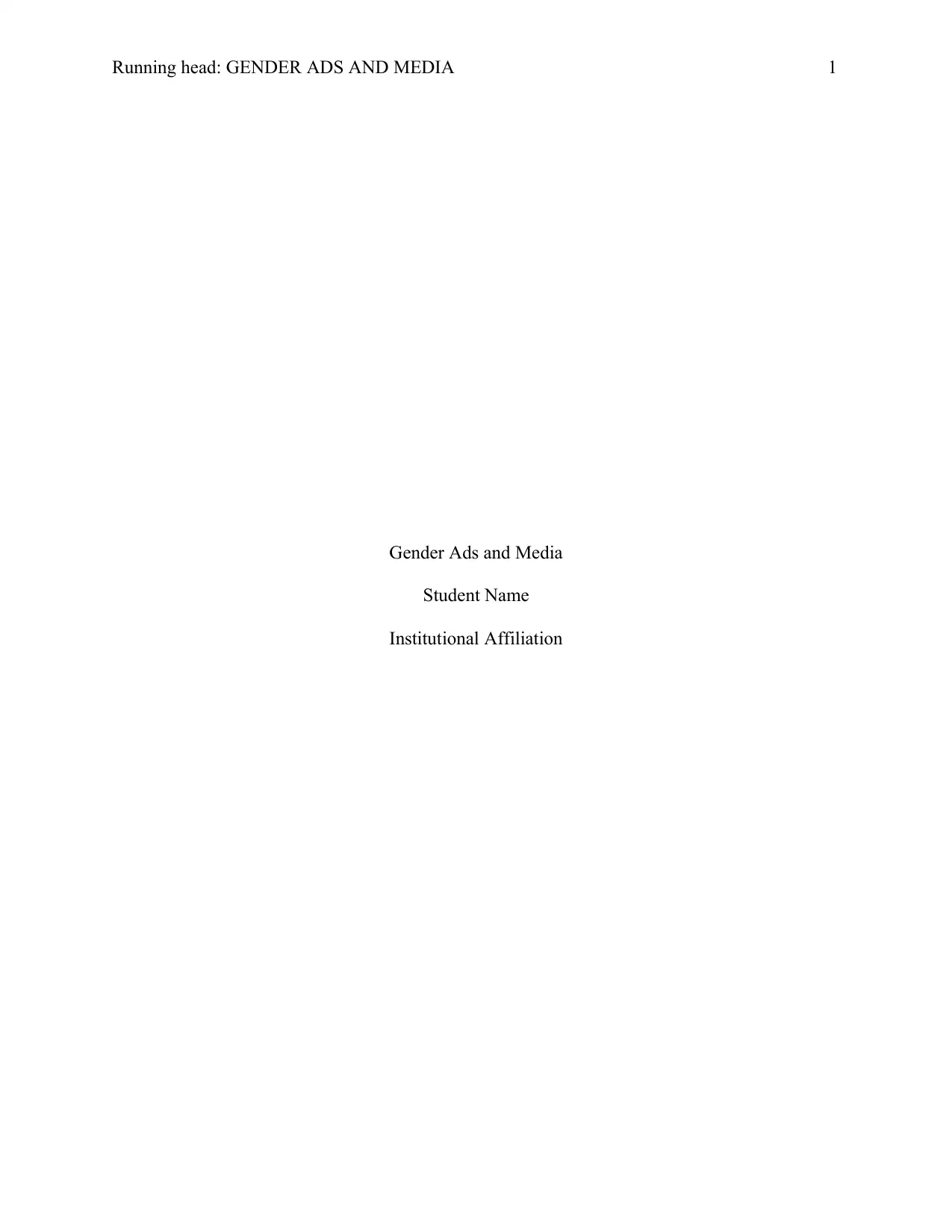
Running head: GENDER ADS AND MEDIA 1
Gender Ads and Media
Student Name
Institutional Affiliation
Gender Ads and Media
Student Name
Institutional Affiliation
Paraphrase This Document
Need a fresh take? Get an instant paraphrase of this document with our AI Paraphraser
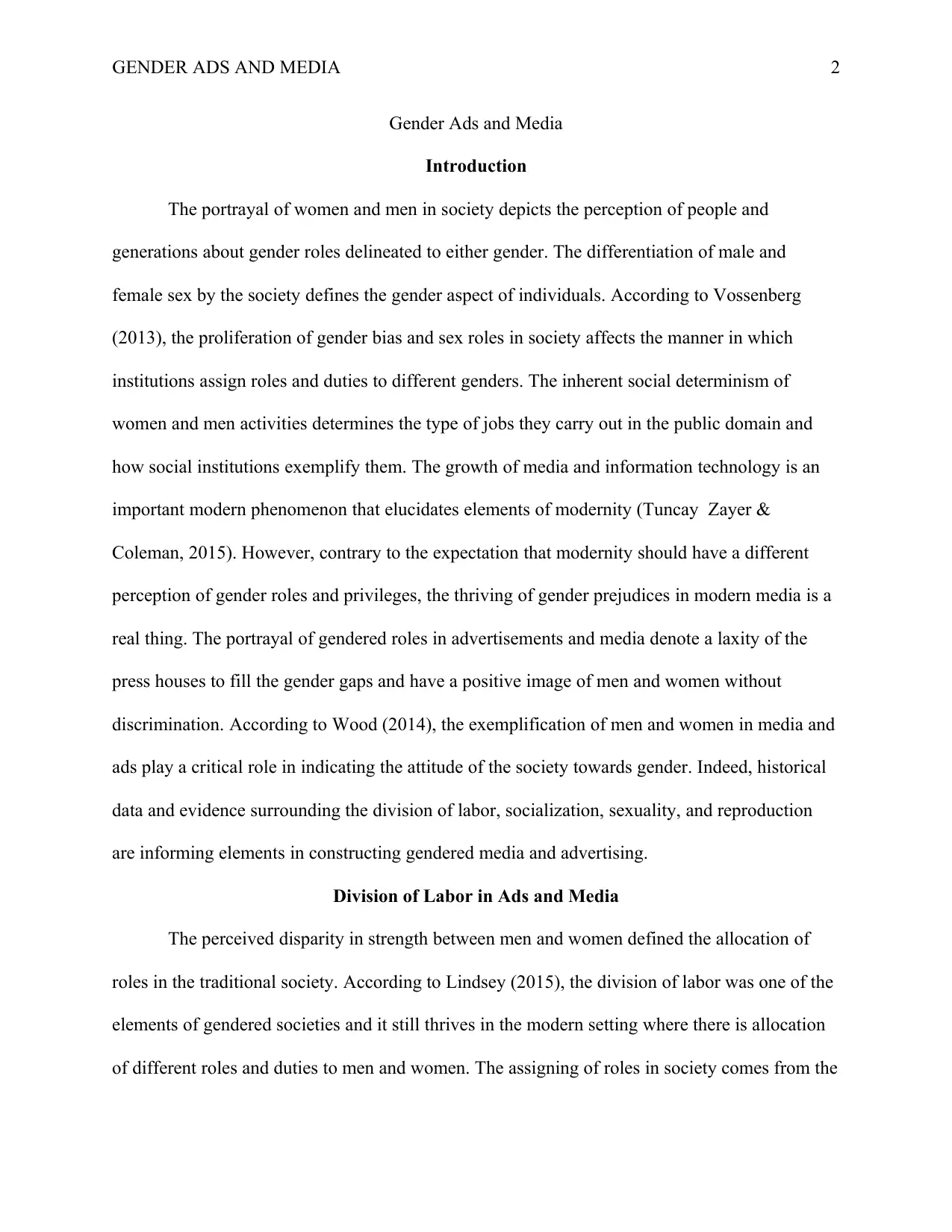
GENDER ADS AND MEDIA 2
Gender Ads and Media
Introduction
The portrayal of women and men in society depicts the perception of people and
generations about gender roles delineated to either gender. The differentiation of male and
female sex by the society defines the gender aspect of individuals. According to Vossenberg
(2013), the proliferation of gender bias and sex roles in society affects the manner in which
institutions assign roles and duties to different genders. The inherent social determinism of
women and men activities determines the type of jobs they carry out in the public domain and
how social institutions exemplify them. The growth of media and information technology is an
important modern phenomenon that elucidates elements of modernity (Tuncay Zayer &
Coleman, 2015). However, contrary to the expectation that modernity should have a different
perception of gender roles and privileges, the thriving of gender prejudices in modern media is a
real thing. The portrayal of gendered roles in advertisements and media denote a laxity of the
press houses to fill the gender gaps and have a positive image of men and women without
discrimination. According to Wood (2014), the exemplification of men and women in media and
ads play a critical role in indicating the attitude of the society towards gender. Indeed, historical
data and evidence surrounding the division of labor, socialization, sexuality, and reproduction
are informing elements in constructing gendered media and advertising.
Division of Labor in Ads and Media
The perceived disparity in strength between men and women defined the allocation of
roles in the traditional society. According to Lindsey (2015), the division of labor was one of the
elements of gendered societies and it still thrives in the modern setting where there is allocation
of different roles and duties to men and women. The assigning of roles in society comes from the
Gender Ads and Media
Introduction
The portrayal of women and men in society depicts the perception of people and
generations about gender roles delineated to either gender. The differentiation of male and
female sex by the society defines the gender aspect of individuals. According to Vossenberg
(2013), the proliferation of gender bias and sex roles in society affects the manner in which
institutions assign roles and duties to different genders. The inherent social determinism of
women and men activities determines the type of jobs they carry out in the public domain and
how social institutions exemplify them. The growth of media and information technology is an
important modern phenomenon that elucidates elements of modernity (Tuncay Zayer &
Coleman, 2015). However, contrary to the expectation that modernity should have a different
perception of gender roles and privileges, the thriving of gender prejudices in modern media is a
real thing. The portrayal of gendered roles in advertisements and media denote a laxity of the
press houses to fill the gender gaps and have a positive image of men and women without
discrimination. According to Wood (2014), the exemplification of men and women in media and
ads play a critical role in indicating the attitude of the society towards gender. Indeed, historical
data and evidence surrounding the division of labor, socialization, sexuality, and reproduction
are informing elements in constructing gendered media and advertising.
Division of Labor in Ads and Media
The perceived disparity in strength between men and women defined the allocation of
roles in the traditional society. According to Lindsey (2015), the division of labor was one of the
elements of gendered societies and it still thrives in the modern setting where there is allocation
of different roles and duties to men and women. The assigning of roles in society comes from the
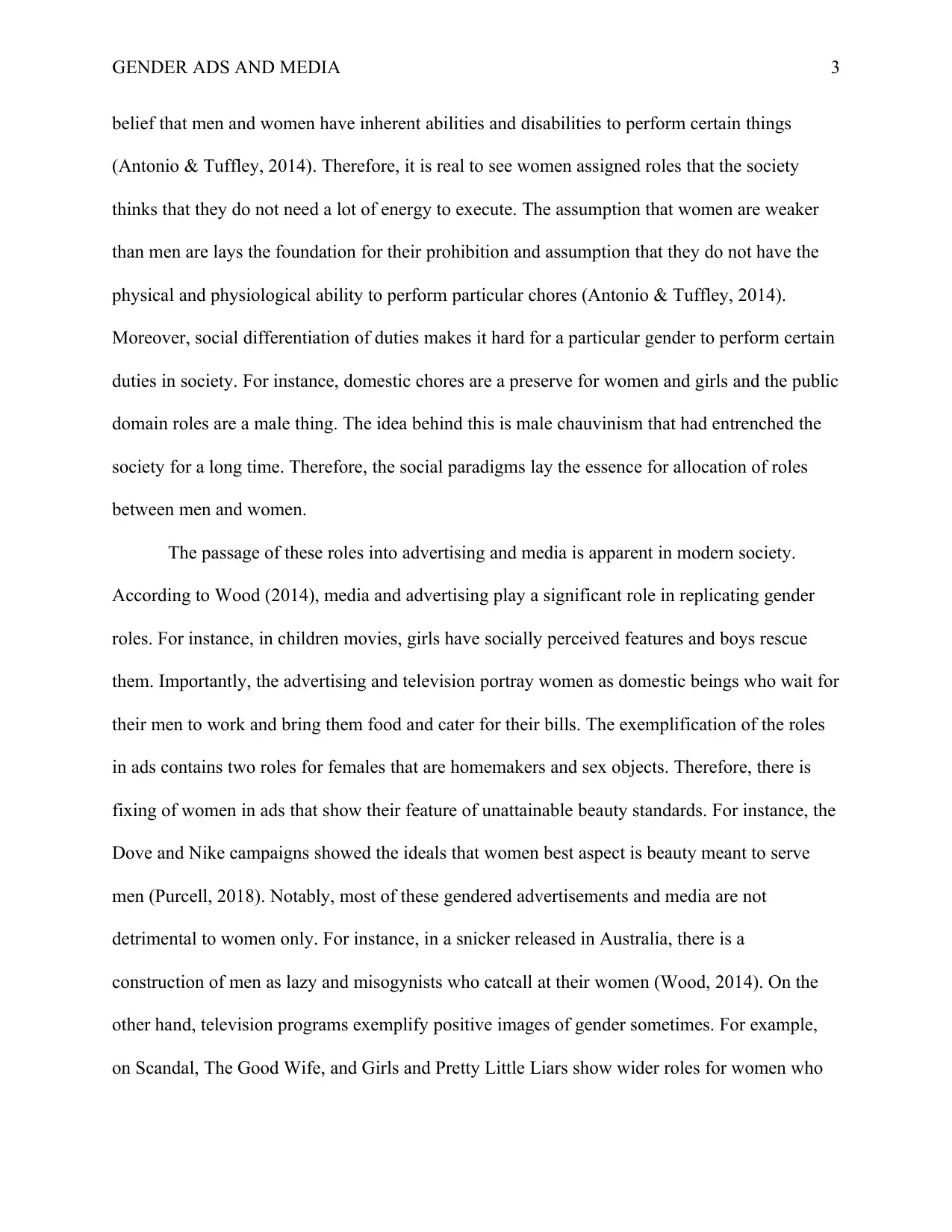
GENDER ADS AND MEDIA 3
belief that men and women have inherent abilities and disabilities to perform certain things
(Antonio & Tuffley, 2014). Therefore, it is real to see women assigned roles that the society
thinks that they do not need a lot of energy to execute. The assumption that women are weaker
than men are lays the foundation for their prohibition and assumption that they do not have the
physical and physiological ability to perform particular chores (Antonio & Tuffley, 2014).
Moreover, social differentiation of duties makes it hard for a particular gender to perform certain
duties in society. For instance, domestic chores are a preserve for women and girls and the public
domain roles are a male thing. The idea behind this is male chauvinism that had entrenched the
society for a long time. Therefore, the social paradigms lay the essence for allocation of roles
between men and women.
The passage of these roles into advertising and media is apparent in modern society.
According to Wood (2014), media and advertising play a significant role in replicating gender
roles. For instance, in children movies, girls have socially perceived features and boys rescue
them. Importantly, the advertising and television portray women as domestic beings who wait for
their men to work and bring them food and cater for their bills. The exemplification of the roles
in ads contains two roles for females that are homemakers and sex objects. Therefore, there is
fixing of women in ads that show their feature of unattainable beauty standards. For instance, the
Dove and Nike campaigns showed the ideals that women best aspect is beauty meant to serve
men (Purcell, 2018). Notably, most of these gendered advertisements and media are not
detrimental to women only. For instance, in a snicker released in Australia, there is a
construction of men as lazy and misogynists who catcall at their women (Wood, 2014). On the
other hand, television programs exemplify positive images of gender sometimes. For example,
on Scandal, The Good Wife, and Girls and Pretty Little Liars show wider roles for women who
belief that men and women have inherent abilities and disabilities to perform certain things
(Antonio & Tuffley, 2014). Therefore, it is real to see women assigned roles that the society
thinks that they do not need a lot of energy to execute. The assumption that women are weaker
than men are lays the foundation for their prohibition and assumption that they do not have the
physical and physiological ability to perform particular chores (Antonio & Tuffley, 2014).
Moreover, social differentiation of duties makes it hard for a particular gender to perform certain
duties in society. For instance, domestic chores are a preserve for women and girls and the public
domain roles are a male thing. The idea behind this is male chauvinism that had entrenched the
society for a long time. Therefore, the social paradigms lay the essence for allocation of roles
between men and women.
The passage of these roles into advertising and media is apparent in modern society.
According to Wood (2014), media and advertising play a significant role in replicating gender
roles. For instance, in children movies, girls have socially perceived features and boys rescue
them. Importantly, the advertising and television portray women as domestic beings who wait for
their men to work and bring them food and cater for their bills. The exemplification of the roles
in ads contains two roles for females that are homemakers and sex objects. Therefore, there is
fixing of women in ads that show their feature of unattainable beauty standards. For instance, the
Dove and Nike campaigns showed the ideals that women best aspect is beauty meant to serve
men (Purcell, 2018). Notably, most of these gendered advertisements and media are not
detrimental to women only. For instance, in a snicker released in Australia, there is a
construction of men as lazy and misogynists who catcall at their women (Wood, 2014). On the
other hand, television programs exemplify positive images of gender sometimes. For example,
on Scandal, The Good Wife, and Girls and Pretty Little Liars show wider roles for women who
⊘ This is a preview!⊘
Do you want full access?
Subscribe today to unlock all pages.

Trusted by 1+ million students worldwide
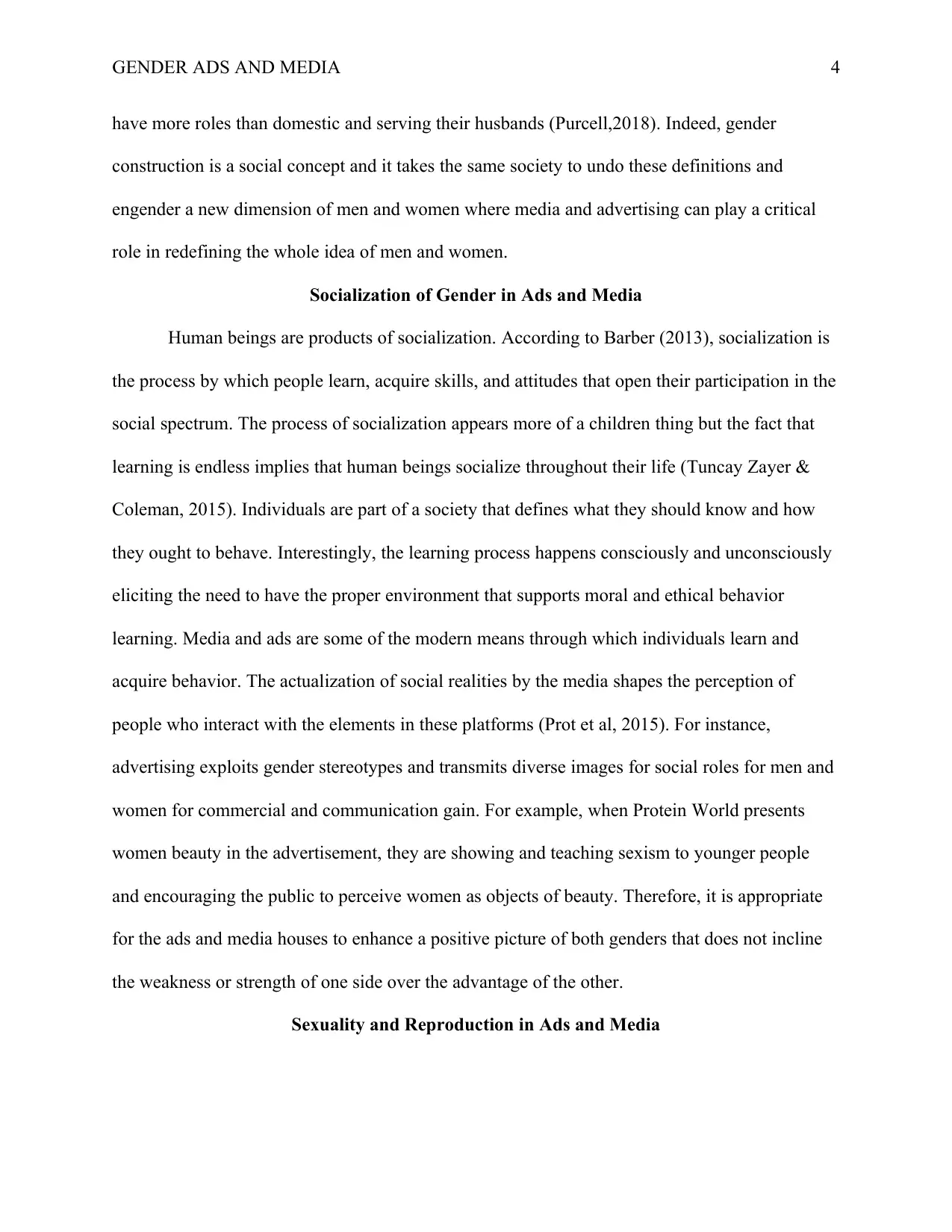
GENDER ADS AND MEDIA 4
have more roles than domestic and serving their husbands (Purcell,2018). Indeed, gender
construction is a social concept and it takes the same society to undo these definitions and
engender a new dimension of men and women where media and advertising can play a critical
role in redefining the whole idea of men and women.
Socialization of Gender in Ads and Media
Human beings are products of socialization. According to Barber (2013), socialization is
the process by which people learn, acquire skills, and attitudes that open their participation in the
social spectrum. The process of socialization appears more of a children thing but the fact that
learning is endless implies that human beings socialize throughout their life (Tuncay Zayer &
Coleman, 2015). Individuals are part of a society that defines what they should know and how
they ought to behave. Interestingly, the learning process happens consciously and unconsciously
eliciting the need to have the proper environment that supports moral and ethical behavior
learning. Media and ads are some of the modern means through which individuals learn and
acquire behavior. The actualization of social realities by the media shapes the perception of
people who interact with the elements in these platforms (Prot et al, 2015). For instance,
advertising exploits gender stereotypes and transmits diverse images for social roles for men and
women for commercial and communication gain. For example, when Protein World presents
women beauty in the advertisement, they are showing and teaching sexism to younger people
and encouraging the public to perceive women as objects of beauty. Therefore, it is appropriate
for the ads and media houses to enhance a positive picture of both genders that does not incline
the weakness or strength of one side over the advantage of the other.
Sexuality and Reproduction in Ads and Media
have more roles than domestic and serving their husbands (Purcell,2018). Indeed, gender
construction is a social concept and it takes the same society to undo these definitions and
engender a new dimension of men and women where media and advertising can play a critical
role in redefining the whole idea of men and women.
Socialization of Gender in Ads and Media
Human beings are products of socialization. According to Barber (2013), socialization is
the process by which people learn, acquire skills, and attitudes that open their participation in the
social spectrum. The process of socialization appears more of a children thing but the fact that
learning is endless implies that human beings socialize throughout their life (Tuncay Zayer &
Coleman, 2015). Individuals are part of a society that defines what they should know and how
they ought to behave. Interestingly, the learning process happens consciously and unconsciously
eliciting the need to have the proper environment that supports moral and ethical behavior
learning. Media and ads are some of the modern means through which individuals learn and
acquire behavior. The actualization of social realities by the media shapes the perception of
people who interact with the elements in these platforms (Prot et al, 2015). For instance,
advertising exploits gender stereotypes and transmits diverse images for social roles for men and
women for commercial and communication gain. For example, when Protein World presents
women beauty in the advertisement, they are showing and teaching sexism to younger people
and encouraging the public to perceive women as objects of beauty. Therefore, it is appropriate
for the ads and media houses to enhance a positive picture of both genders that does not incline
the weakness or strength of one side over the advantage of the other.
Sexuality and Reproduction in Ads and Media
Paraphrase This Document
Need a fresh take? Get an instant paraphrase of this document with our AI Paraphraser
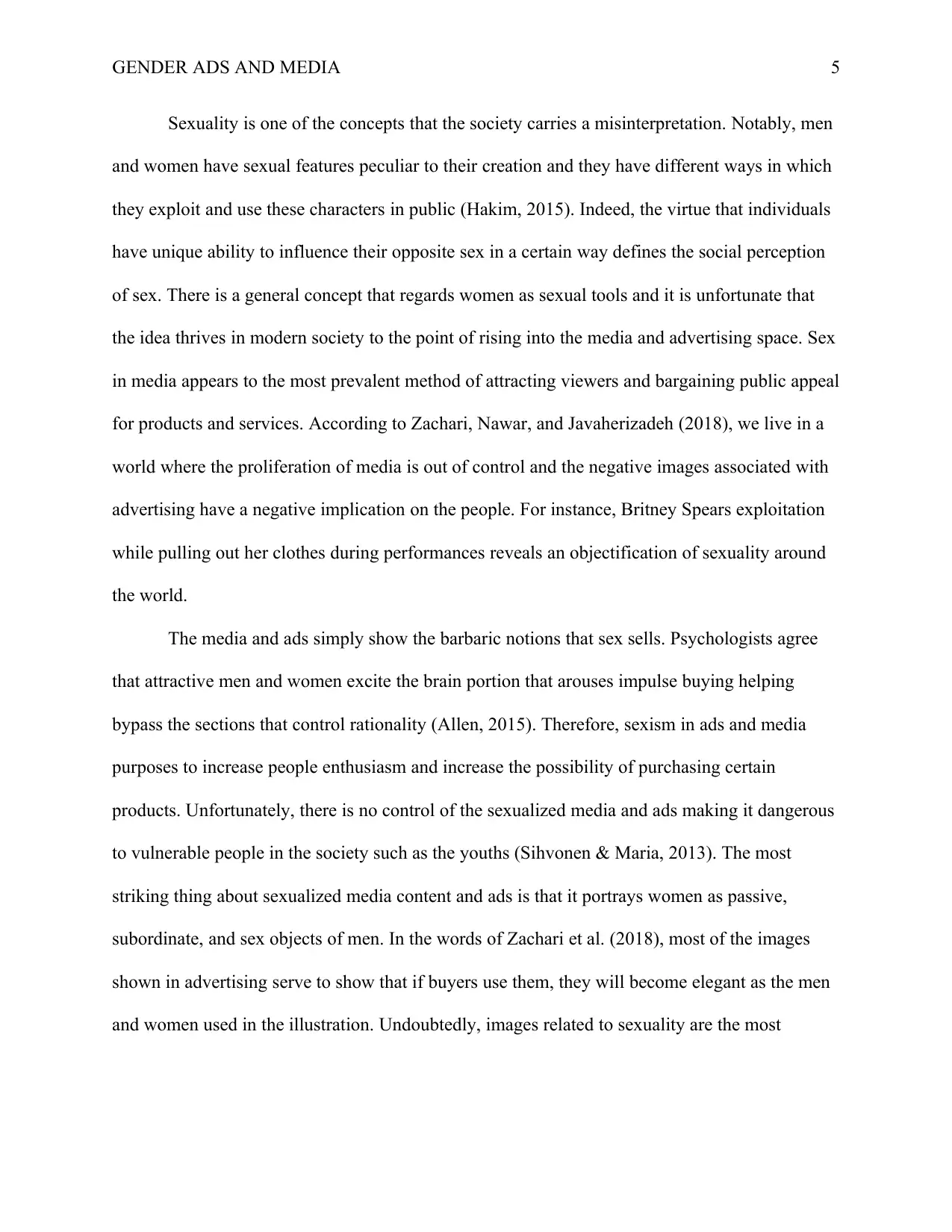
GENDER ADS AND MEDIA 5
Sexuality is one of the concepts that the society carries a misinterpretation. Notably, men
and women have sexual features peculiar to their creation and they have different ways in which
they exploit and use these characters in public (Hakim, 2015). Indeed, the virtue that individuals
have unique ability to influence their opposite sex in a certain way defines the social perception
of sex. There is a general concept that regards women as sexual tools and it is unfortunate that
the idea thrives in modern society to the point of rising into the media and advertising space. Sex
in media appears to the most prevalent method of attracting viewers and bargaining public appeal
for products and services. According to Zachari, Nawar, and Javaherizadeh (2018), we live in a
world where the proliferation of media is out of control and the negative images associated with
advertising have a negative implication on the people. For instance, Britney Spears exploitation
while pulling out her clothes during performances reveals an objectification of sexuality around
the world.
The media and ads simply show the barbaric notions that sex sells. Psychologists agree
that attractive men and women excite the brain portion that arouses impulse buying helping
bypass the sections that control rationality (Allen, 2015). Therefore, sexism in ads and media
purposes to increase people enthusiasm and increase the possibility of purchasing certain
products. Unfortunately, there is no control of the sexualized media and ads making it dangerous
to vulnerable people in the society such as the youths (Sihvonen & Maria, 2013). The most
striking thing about sexualized media content and ads is that it portrays women as passive,
subordinate, and sex objects of men. In the words of Zachari et al. (2018), most of the images
shown in advertising serve to show that if buyers use them, they will become elegant as the men
and women used in the illustration. Undoubtedly, images related to sexuality are the most
Sexuality is one of the concepts that the society carries a misinterpretation. Notably, men
and women have sexual features peculiar to their creation and they have different ways in which
they exploit and use these characters in public (Hakim, 2015). Indeed, the virtue that individuals
have unique ability to influence their opposite sex in a certain way defines the social perception
of sex. There is a general concept that regards women as sexual tools and it is unfortunate that
the idea thrives in modern society to the point of rising into the media and advertising space. Sex
in media appears to the most prevalent method of attracting viewers and bargaining public appeal
for products and services. According to Zachari, Nawar, and Javaherizadeh (2018), we live in a
world where the proliferation of media is out of control and the negative images associated with
advertising have a negative implication on the people. For instance, Britney Spears exploitation
while pulling out her clothes during performances reveals an objectification of sexuality around
the world.
The media and ads simply show the barbaric notions that sex sells. Psychologists agree
that attractive men and women excite the brain portion that arouses impulse buying helping
bypass the sections that control rationality (Allen, 2015). Therefore, sexism in ads and media
purposes to increase people enthusiasm and increase the possibility of purchasing certain
products. Unfortunately, there is no control of the sexualized media and ads making it dangerous
to vulnerable people in the society such as the youths (Sihvonen & Maria, 2013). The most
striking thing about sexualized media content and ads is that it portrays women as passive,
subordinate, and sex objects of men. In the words of Zachari et al. (2018), most of the images
shown in advertising serve to show that if buyers use them, they will become elegant as the men
and women used in the illustration. Undoubtedly, images related to sexuality are the most
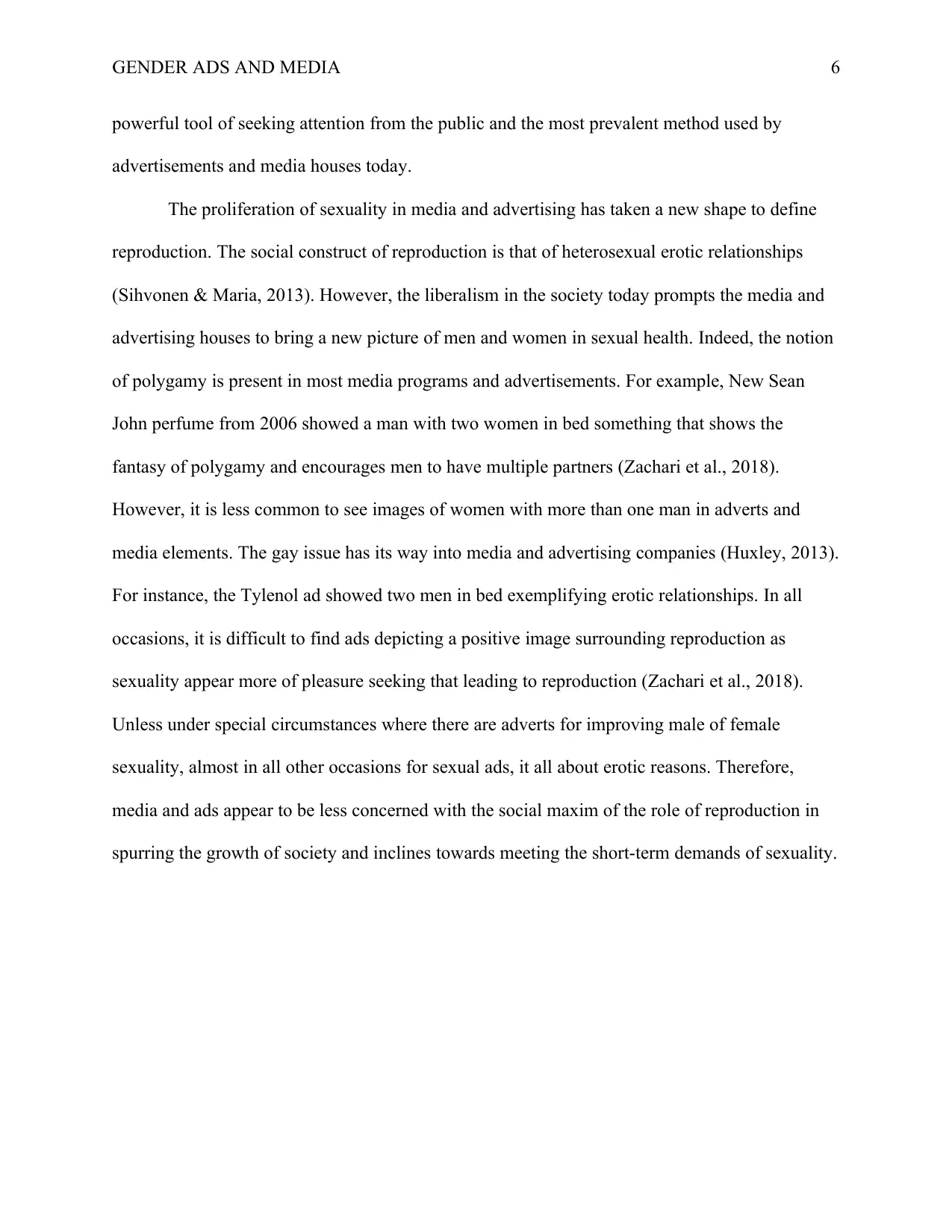
GENDER ADS AND MEDIA 6
powerful tool of seeking attention from the public and the most prevalent method used by
advertisements and media houses today.
The proliferation of sexuality in media and advertising has taken a new shape to define
reproduction. The social construct of reproduction is that of heterosexual erotic relationships
(Sihvonen & Maria, 2013). However, the liberalism in the society today prompts the media and
advertising houses to bring a new picture of men and women in sexual health. Indeed, the notion
of polygamy is present in most media programs and advertisements. For example, New Sean
John perfume from 2006 showed a man with two women in bed something that shows the
fantasy of polygamy and encourages men to have multiple partners (Zachari et al., 2018).
However, it is less common to see images of women with more than one man in adverts and
media elements. The gay issue has its way into media and advertising companies (Huxley, 2013).
For instance, the Tylenol ad showed two men in bed exemplifying erotic relationships. In all
occasions, it is difficult to find ads depicting a positive image surrounding reproduction as
sexuality appear more of pleasure seeking that leading to reproduction (Zachari et al., 2018).
Unless under special circumstances where there are adverts for improving male of female
sexuality, almost in all other occasions for sexual ads, it all about erotic reasons. Therefore,
media and ads appear to be less concerned with the social maxim of the role of reproduction in
spurring the growth of society and inclines towards meeting the short-term demands of sexuality.
powerful tool of seeking attention from the public and the most prevalent method used by
advertisements and media houses today.
The proliferation of sexuality in media and advertising has taken a new shape to define
reproduction. The social construct of reproduction is that of heterosexual erotic relationships
(Sihvonen & Maria, 2013). However, the liberalism in the society today prompts the media and
advertising houses to bring a new picture of men and women in sexual health. Indeed, the notion
of polygamy is present in most media programs and advertisements. For example, New Sean
John perfume from 2006 showed a man with two women in bed something that shows the
fantasy of polygamy and encourages men to have multiple partners (Zachari et al., 2018).
However, it is less common to see images of women with more than one man in adverts and
media elements. The gay issue has its way into media and advertising companies (Huxley, 2013).
For instance, the Tylenol ad showed two men in bed exemplifying erotic relationships. In all
occasions, it is difficult to find ads depicting a positive image surrounding reproduction as
sexuality appear more of pleasure seeking that leading to reproduction (Zachari et al., 2018).
Unless under special circumstances where there are adverts for improving male of female
sexuality, almost in all other occasions for sexual ads, it all about erotic reasons. Therefore,
media and ads appear to be less concerned with the social maxim of the role of reproduction in
spurring the growth of society and inclines towards meeting the short-term demands of sexuality.
⊘ This is a preview!⊘
Do you want full access?
Subscribe today to unlock all pages.

Trusted by 1+ million students worldwide
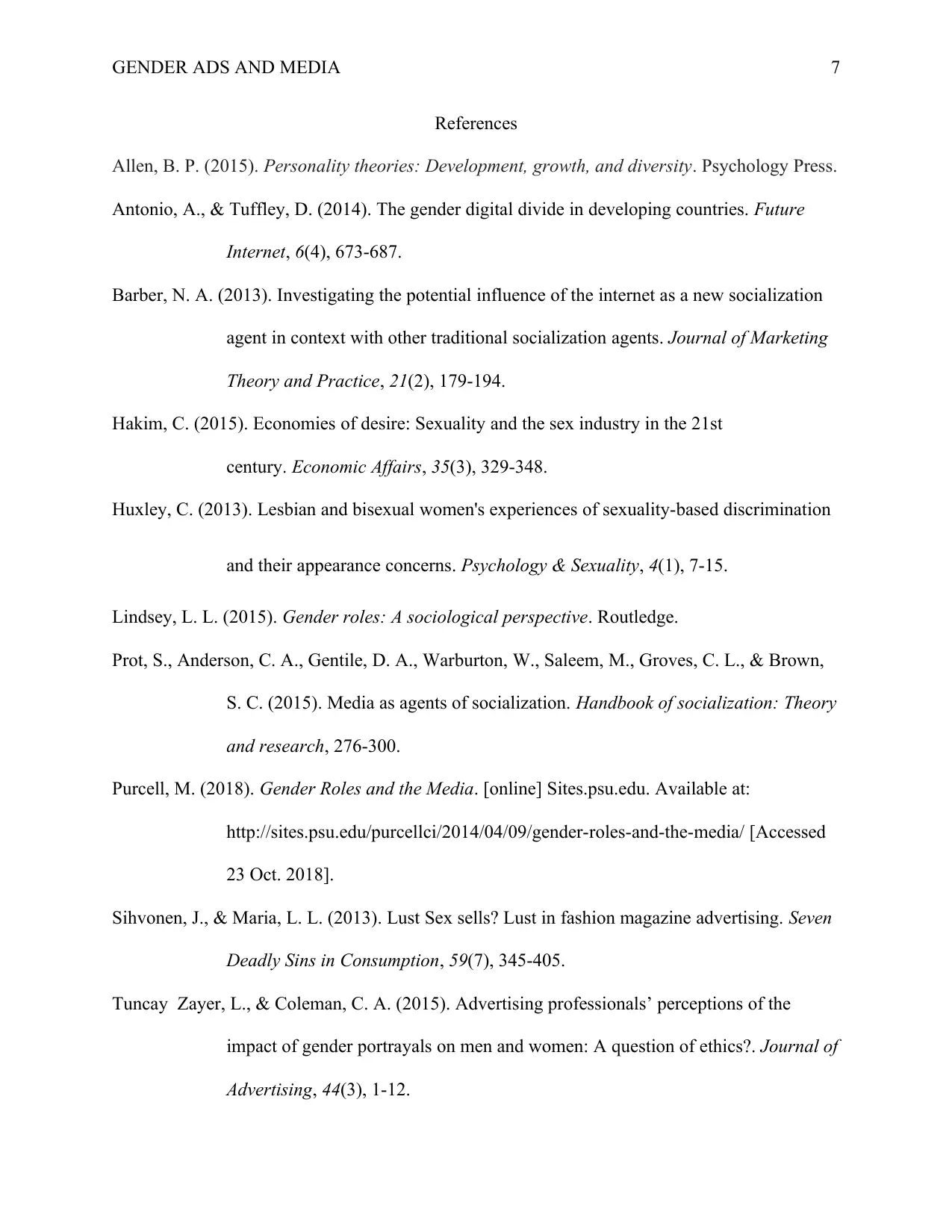
GENDER ADS AND MEDIA 7
References
Allen, B. P. (2015). Personality theories: Development, growth, and diversity. Psychology Press.
Antonio, A., & Tuffley, D. (2014). The gender digital divide in developing countries. Future
Internet, 6(4), 673-687.
Barber, N. A. (2013). Investigating the potential influence of the internet as a new socialization
agent in context with other traditional socialization agents. Journal of Marketing
Theory and Practice, 21(2), 179-194.
Hakim, C. (2015). Economies of desire: Sexuality and the sex industry in the 21st
century. Economic Affairs, 35(3), 329-348.
Huxley, C. (2013). Lesbian and bisexual women's experiences of sexuality-based discrimination
and their appearance concerns. Psychology & Sexuality, 4(1), 7-15.
Lindsey, L. L. (2015). Gender roles: A sociological perspective. Routledge.
Prot, S., Anderson, C. A., Gentile, D. A., Warburton, W., Saleem, M., Groves, C. L., & Brown,
S. C. (2015). Media as agents of socialization. Handbook of socialization: Theory
and research, 276-300.
Purcell, M. (2018). Gender Roles and the Media. [online] Sites.psu.edu. Available at:
http://sites.psu.edu/purcellci/2014/04/09/gender-roles-and-the-media/ [Accessed
23 Oct. 2018].
Sihvonen, J., & Maria, L. L. (2013). Lust Sex sells? Lust in fashion magazine advertising. Seven
Deadly Sins in Consumption, 59(7), 345-405.
Tuncay Zayer, L., & Coleman, C. A. (2015). Advertising professionals’ perceptions of the
impact of gender portrayals on men and women: A question of ethics?. Journal of
Advertising, 44(3), 1-12.
References
Allen, B. P. (2015). Personality theories: Development, growth, and diversity. Psychology Press.
Antonio, A., & Tuffley, D. (2014). The gender digital divide in developing countries. Future
Internet, 6(4), 673-687.
Barber, N. A. (2013). Investigating the potential influence of the internet as a new socialization
agent in context with other traditional socialization agents. Journal of Marketing
Theory and Practice, 21(2), 179-194.
Hakim, C. (2015). Economies of desire: Sexuality and the sex industry in the 21st
century. Economic Affairs, 35(3), 329-348.
Huxley, C. (2013). Lesbian and bisexual women's experiences of sexuality-based discrimination
and their appearance concerns. Psychology & Sexuality, 4(1), 7-15.
Lindsey, L. L. (2015). Gender roles: A sociological perspective. Routledge.
Prot, S., Anderson, C. A., Gentile, D. A., Warburton, W., Saleem, M., Groves, C. L., & Brown,
S. C. (2015). Media as agents of socialization. Handbook of socialization: Theory
and research, 276-300.
Purcell, M. (2018). Gender Roles and the Media. [online] Sites.psu.edu. Available at:
http://sites.psu.edu/purcellci/2014/04/09/gender-roles-and-the-media/ [Accessed
23 Oct. 2018].
Sihvonen, J., & Maria, L. L. (2013). Lust Sex sells? Lust in fashion magazine advertising. Seven
Deadly Sins in Consumption, 59(7), 345-405.
Tuncay Zayer, L., & Coleman, C. A. (2015). Advertising professionals’ perceptions of the
impact of gender portrayals on men and women: A question of ethics?. Journal of
Advertising, 44(3), 1-12.
Paraphrase This Document
Need a fresh take? Get an instant paraphrase of this document with our AI Paraphraser
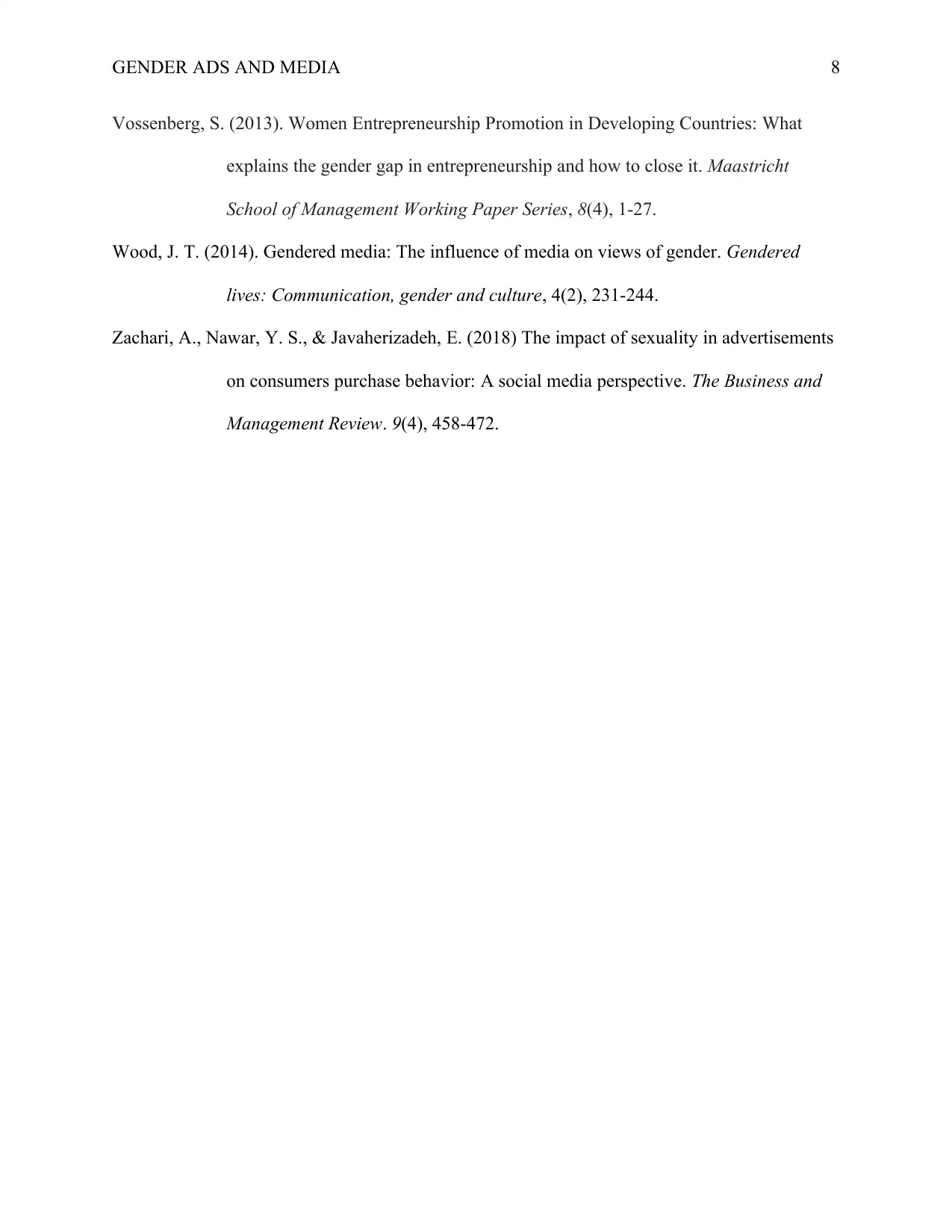
GENDER ADS AND MEDIA 8
Vossenberg, S. (2013). Women Entrepreneurship Promotion in Developing Countries: What
explains the gender gap in entrepreneurship and how to close it. Maastricht
School of Management Working Paper Series, 8(4), 1-27.
Wood, J. T. (2014). Gendered media: The influence of media on views of gender. Gendered
lives: Communication, gender and culture, 4(2), 231-244.
Zachari, A., Nawar, Y. S., & Javaherizadeh, E. (2018) The impact of sexuality in advertisements
on consumers purchase behavior: A social media perspective. The Business and
Management Review. 9(4), 458-472.
Vossenberg, S. (2013). Women Entrepreneurship Promotion in Developing Countries: What
explains the gender gap in entrepreneurship and how to close it. Maastricht
School of Management Working Paper Series, 8(4), 1-27.
Wood, J. T. (2014). Gendered media: The influence of media on views of gender. Gendered
lives: Communication, gender and culture, 4(2), 231-244.
Zachari, A., Nawar, Y. S., & Javaherizadeh, E. (2018) The impact of sexuality in advertisements
on consumers purchase behavior: A social media perspective. The Business and
Management Review. 9(4), 458-472.
1 out of 8
Related Documents
Your All-in-One AI-Powered Toolkit for Academic Success.
+13062052269
info@desklib.com
Available 24*7 on WhatsApp / Email
![[object Object]](/_next/static/media/star-bottom.7253800d.svg)
Unlock your academic potential
Copyright © 2020–2025 A2Z Services. All Rights Reserved. Developed and managed by ZUCOL.




